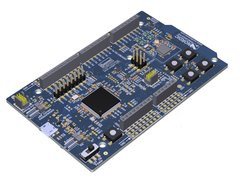Nordic nRF51-DK
The nRF51 Development Kit is a single-board development kit for Bluetooth Smart, ANT and 2.4GHz proprietary applications using the nRF51 Series SoC. This kit supports both development for both nRF51822 and nRF51422 SoCs.

The kit is compatible with the Arduino Uno Revision 3 standard, making it possible to use 3rd-party shield that are compatible to this standard with the kit.
The kit supports the standard Nordic Software Development Tool-chain using Keil, IAR and GCC. The kit also supports ARM mbed tool-chain for rapid prototyping and development using mbed’s cloud-based IDE and tool-chain with an extensive range of open-source software libraries. Program/Debug options on the kit are Segger J-Link Lite for standard tool-chain and CMSIS-DAP for mbed. The kit gives access to all I/O and interfaces via connectors and has 4 LEDs and 4 buttons which are user-programmable. A range of software examples are available from the nRF51 SDK to support Bluetooth Smart, ANT and 2.4GHz applications.

Features¶
- Nordic nRF51 (both nRF51822 and nRF51422) System-on-Chip combining Bluetooth v4.1-compliant 2.4GHz multiprotocol radio and ARM® Cortex®-M0 processor on a single chip optimized for ultra-low power operation
- Arduino Uno Rev. 3 compatible connector for use with 3rd party shields
- All I/O and interfaces available via connectors
- USB drag and drop programming and USB Virtual COM port for serial terminal
- Segger J-Link and CMSIS-DAP interface for programming and debugging from offline tools and pyOCD
- Connector for RF measurements
- Pins for power consumption measurements
- Accepts power through:
- USB
- External source (1.8V-3.6V)
- Single 2032 coin-cell battery, onboard battery holder
Support for FOTA¶
Note
We now have support for Firmware Over The Air (or FOTA for short) for this platform. This means that you can program the nRF51-DK without going through the mbed interface chip over USB. No need for cables except for an initial install of the bootloader image (or as a fallback). And you can get console output over the air as well. Yay!!
Binaries built for FOTA need a minor change in the toolchain (they don't need to be combined with the softdevice), and so we've cloned the build platform into a 'shadow' platform for FOTA. You can access this shadow platform by following this link.
Firmware Update¶
The latest Arm Mbed DAPLink interface firmware for the nRF51-DK is available at (click the image):
Source: https://github.com/ARMmbed/DAPLink
BLE stack¶
Nordic Semiconductor provides a wireless protocol stack called the SoftDevice. The SoftDevice is precompiled into a binary image and functionally verified according to the wireless protocol specification, so that all you have to think about is creating the application.
compiled binary size
For the default DK mbed target, any mbed build tools (online IDE, mbed CLI) will put the SoftDevice and the user application together into a binary file intended to program your development kit. Be aware of the SoftDevice size – it adds more than a hundred KB to any compiled binaries.
Further information about the type of Nordic’s target is available in nRF5 ReadMe.
Other Resources¶
You can find detailed information about this platform on the nRF51 DK User Guide download page.
For any nRF51-DK related questions you can also search and post questions on NORDIC DEVELOPER ZONE
A team of summer interns at Nordic have recently developed a library for easier setup and prototyping of IoT devices for the nRF51822. This could be useful when developing applications for the nRF51-DK.
Known issues¶
Impossible to debug or flash an application with IAR using CMSIS-DAP.
- Description: It is not possible to flash or debug an application with IAR on the Nordic target. This issue is caused by a bad interaction between CMSIS-DAP IF present on the Nordic boards and IAR CMSIS-DAP debug driver.
- Workaround: The best solution is to switch to the JLINK IF image and configure the IAR project to use it.
- Download the JLINK IF and install it on the board.
- Open the exported project in IAR then go to its options.
- Go to the debugger section
- In the setup tab choose J-link/J-trace as the debug driver.
- In the Download tab disable the Use flash loader(s) option.
- In the Extra options tabs, tick the Use command line options and add the following content:
--drv_vector_table_base=0x0
You need to log in to post a discussion
Discussion topics
| Topic | Replies | Last post |
|---|---|---|
| nRF52832 Board usage | 0 |
10 Jan 2017
by
|
| led, nRF51-DK Device will not show up when plugged in, shows three LEDs | 0 |
15 Nov 2016
by
|


